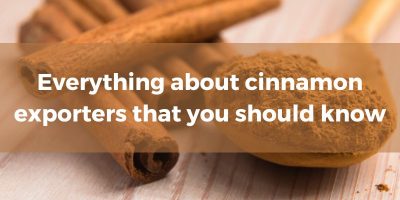Discover how this distinct, aromatic spice presents profitable opportunities for wholesalers, from sourcing strategies, and market trends, to innovative ways to capitalize on global demand. Uncover the potential for your business with Vietnamese cinnamon sticks.
General information about Vietnamese Cinnamon Sticks
Here are the unique properties of Vietnamese cinnamon sticks and their export situation.
Exploring the unique properties of Vietnamese cinnamon sticks
Vietnamese cinnamon sticks, also known as Saigon cinnamon, have several distinguishing characteristics:
- Vietnamese cinnamon is prized for its warm, sweet, and spicy flavor, as well as its strong aroma. It has a richer, more complex flavor than the other varieties.
- Vietnamese cinnamon sticks have a high concentration of essential oil, specifically cinnamaldehyde (up to 6%), which accounts for its strong flavor and aroma.
- It has a high concentration of antioxidants and anti-inflammatory properties. It has traditionally been used in traditional medicine to treat conditions such as indigestion and diabetes.
- Texture and Appearance: Unlike Ceylon or Cassia cinnamon, Vietnamese cinnamon sticks are thick, dark brown, and have a rough texture.
- Heat Stability: Their intense flavor remains stable even when heated, making these cinnamon sticks suitable for baking or cooking.
- They can be used in both sweet and savory dishes, adding depth of flavor to a variety of dishes.
Please keep in mind that excessive consumption can be harmful because it contains coumarin, a natural substance that, when consumed in large quantities, can cause liver damage.
The Vietnam cinnamon stick export situation nowadays
Vietnam was one of the leading exporters of cinnamon, including cinnamon sticks, due to favorable climate and farming techniques. The major importers were countries like the USA, India, and in the European Union. For the most recent and accurate data, please refer to the latest reports from relevant trade and export organizations, or the Ministry of Industry and Trade of Vietnam.
Vietnam exports hundreds of thousands of tons of cinnamon annually, with the main markets being the United States, Europe (especially Germany), and Asian countries like India. Exports are not limited to cinnamon sticks but also include ground cinnamon, cinnamon oil, and other products. The Vietnamese cinnamon industry has seen stable growth, with market expansion and increases in both the value and volume of exports. However, the Vietnam cinnamon export also faces challenges, such as global price fluctuations, compliance with international quality standards, and sustainable production management. The cinnamon industry plays a significant role in Vietnam’s economy, providing income for thousands of farmers and businesses.
Harvesting and production process of Vietnamese cinnamon sticks
Several key steps are involved in the harvesting and production of Vietnamese cinnamon sticks:
- Harvesting and growing: Cinnamon trees, specifically the Cinnamomum cassia species, are grown in Vietnam due to the country’s favorable climatic conditions. The trees are allowed to grow for about two years before being harvested. During the rainy season, when the bark is easier to peel off, it is harvested.
- Peeling the Bark: The outer bark is scraped away, and the inner bark is carefully removed. The cinnamon layer is the inner bark. As the strips dry, they naturally curl into rolls.
- After that, the cinnamon strips are sun-dried. As they dry, they curl up and turn brown, forming cinnamon sticks or “quills.”
- Grading and Sorting: The Vietnamese cinnamon sticks are sorted based on size, color, and quality after drying. Only the highest quality cinnamon sticks are exported whole, while broken pieces and lower quality cinnamon sticks are ground into cinnamon powder.
- Exporting and packaging: The cinnamon sticks are then packaged for export. To keep their flavor and aroma, they must be stored in a dry place.
It should be noted that the manufacturing process, particularly the stripping and drying of the bark, necessitates skilled craftsmanship and care.
How wholesalers can benefit from importing Vietnamese cinnamon sticks
Wholesalers can gain several benefits from importing Vietnamese cinnamon sticks:
- Premium Quality: Vietnamese cinnamon, also known as Saigon cinnamon, is known for its high quality. It’s especially prized for its sweet and spicy flavor and high oil content, characteristics that make it stand out among other cinnamon types.
- Profitably: Due to its superior flavor profile, Vietnamese cinnamon can command higher prices in many markets. Therefore, those who import it can potentially realize larger profit margins.
- Diverse Applications: Vietnamese cinnamon is versatile and can be used in a wide variety of cuisines and products, from baked goods and confectioneries to savory dishes, beverages, and cosmetics. This wide range of applications can help wholesalers reach an extensive customer base.
- Increasing Demand: There is a growing global demand for natural, high-quality spices, including cinnamon. Importing premium Vietnamese cinnamon can help meet this demand and capture market share.
- Eco-friendly Farming Practices: Many Vietnamese cinnamon sticks farmers employ sustainable farming practices, which is an added advantage for wholesalers targeting eco-conscious consumers.
- Potential for Brand Building: Wholesalers importing unique products like Vietnamese cinnamon have a chance to build a strong brand name and reputation in the spice industry.
Remember, it’s important to ensure the reliability and compliance of suppliers with international food safety standards for successful import business.






Trả lời